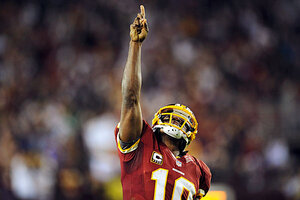Robert Griffin III plays like Tim Tebow, only better
Robert Griffin III, aka RG3, gives NFL fans something different by running the triple option offense. But RG3 must continue to evolve his QB skills to survive in the NFL.

Washington Redskins quarterback Robert Griffin III points skyward after throwing a touchdown pass to wide receiver Pierre Garcon during win over the New York Giants, Monday, Dec. 3, 2012.
(AP Photo/Nick Wass)
After watching Robert Griffin III lead the Washington Redskins to a 17-16 win Monday night over the New York Giants, something jumps out: If you look closely, he's basically a really good Tim Tebow.
The Redskins (this year) and Broncos (last year) offenses are built on the triple option – a scheme that creates indecision among defenders because the quarterback himself can keep the ball as a running back. The scheme also makes it easier for quarterbacks to pass the ball, since defenses often have to over-commit to stopping the run.
This helped Tebow lead the Broncos to the playoffs, even though he was – by many measures – a poor passer. The difference is that RG3 is an exceptional passer, so he can routinely hit the receivers left open by the confusion that the triple option creates.
In essence, RG3 is Tebow 2.0.
The catch is that triple option quarterbacks – by doubling as a running back – take a lot of hits. The Redskins coaching staff will have to decide whether it continues with the triple option in years ahead or adjusts its schemes to let RG3 become a more typical pocket passer (who takes fewer hits). RG3's intelligence and skills suggest he's capable of evolving.
Former San Francisco 49er quarterback Steve Young, now an ESPN analyst, said Monday that the triple option has to be a transitional plan to give RG3 a soft landing in the pro game, not a long-term strategy. As a mobile QB who was knocked out of the game by concussions, Young speaks from experience.
Regardless of how RG3 evolves, his success with the triple option does settle one lingering question in the Great Tebow Debate: With the right pieces, a college-style offense that relies heavily on athletic ability and improvisation can succeed in the National Football League, at least for a while.
If Tebow were a better passer, perhaps he could run this kind of offense for years, because he's built like a fullback. But it's unlikely that RG3 would be able to withstand such a pounding. In the meantime, it is fun to watch.
Where do the other NFL rookie QBs, such as Seattle Seahawk Russell Wilson and Indianapolis Colt Andrew Luck, fit into this picture?
Despite their skills running the ball, neither Wilson nor Luck runs an offense like RG3. Wilson, the more gifted runner of the two, is more Drew Brees than Michael Vick. He – and his coaches – know that his speed and agility are weapons, and they use them to great effect several times a game. But Wilson is not a hybrid QB like RG3 or Tim Tebow.
Instead, the coaches have slowly trusted him with more and more of their pro-style playbook. When the season started, they put the team largely in the hands of running back Marshawn Lynch and a strong defense. But since Week 5, Wilson has been the best quarterback in the league by some measures.
What sets Luck apart is that he was given the keys to a pro-style offense from Day 1 – for a team that went 2-14 last year and lacks either a dominant running game or defense. In essence, the Colts heaped everything on his back and even took away the training wheels – and amazingly, his Colts are 8-4 and in playoff contention. Even his predecessor, Peyton Manning, wasn't given as much to process as Luck, says interim head coach Bruce Arians, who was Manning's quarterback coach when Manning was a rookie.
Luck's play this year has elicited generous praise, including from Nate Dunlevy at the Bleacher Report.
"I want to laugh when people get all serious and grave about Luck's interceptions. He's throwing the ball 50-60 times a game in a purely vertical offense with a bunch of rookies and a crappy line.
You expect rookies to throw picks. You expect rookies to make bad reads. You expect rookies to have unrealistic expectations of their own ability to make a stick throw. You don't expect rookies do to any of the other things that Luck does.
Counterfeit experts spend all their time studying real bills. They never bother to look at fakes.
I've spent the last 12 years dissecting the play of Peyton Manning. I know the real thing when I see it. You can't fool someone who's seen the genuine article."
In comparing Luck and RG3, the difference is workload. The success of the triple option helps RG3 to be remarkably efficient. He knows where the ball needs to go, and he puts it there. When RG3 needs to become a pure dropback passer, however, his success suffers. The Redskins have won only one of the six games in which RG3 attempted 28 or more passes.
Meanwhile, with no effective running game to protect him, Luck has attempted fewer than 28 passes only once and has attempted 45 or more passes six times (with a 3-3 record).
Both RG3 and Luck are doing things never before seen in the NFL, and they're doing it in completely different ways.

